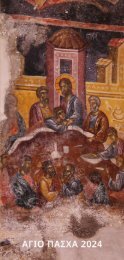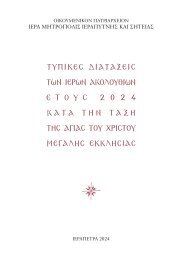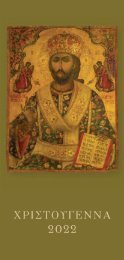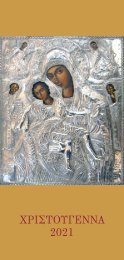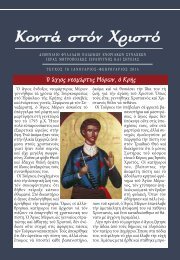You also want an ePaper? Increase the reach of your titles
YUMPU automatically turns print PDFs into web optimized ePapers that Google loves.
THE CHURCHES<br />
AT IERAPETRA<br />
50<br />
The twin-naved church, dedicated to Christ the Master and St. Charalambos, which<br />
is located in the port, to the west of the medieval fortress of Kales, is the oldest<br />
church of the city. Its architectural form is the result of interpolations to a barrel-vaulted,<br />
single-nave church of the Venetian period to which, during the early 17th century, one<br />
more aisle to the south was added, the one dedicated today to St.<br />
Charalambos. A group of<br />
three icons of the first half<br />
of the 18th century on the<br />
altar screen of the church which have been<br />
attributed to the famous painter, George<br />
Kastrophylakas, are of interest. A narthex<br />
with two domes was added in later years to<br />
the west of the church, which subsequently<br />
was expanded. This surviving church is<br />
possibly identified with the church of the<br />
Saviour, for which rich archival material<br />
survives, and which had been the object of<br />
dispute between the Orthodox and Roman<br />
Catholic Christians of the city, since it housed<br />
both denominations. The dispute was<br />
created when the Franciscan hieromonk,<br />
Paul Mudarro, who served in the church,<br />
decided to appropriate it on behalf of the<br />
Franciscan order, abolishing the Orthodox<br />
altar screen and building a chapel which is<br />
probably identical to the present south aisle.<br />
The dispute ended after the intervention of<br />
the general provedditore of Crete, Francesco<br />
Morosini, with more beneficial terms for the The Dormition of the Theotokos. Christ the Saviour.<br />
Roman Catholics as it was suggested that<br />
the south chapel be used exclusively by them, while the church of the Saviour by both<br />
denominations, after the area of the sanctuary was<br />
suitably structured.<br />
The barrel-vaulted, single-nave church of St.<br />
Nicholas is located further to the west of Christ<br />
the Master. It is also clear that this is a building of<br />
the Venetian period, even though it has been<br />
subjected to interpolations during later years, such<br />
as the opening of the western entrance. In the<br />
interior a signed icon of the Holy Trinity of the 18th<br />
century, is preserved, work of the painter George<br />
Kastrophylakas.<br />
Church of St. Nicholas.<br />
The most important church of the city<br />
is the metropolitan church of St. George,<br />
who is also the patron saint of Ierapetra<br />
due to his wonderworking interventions<br />
during the period of Turkish occupation.<br />
The church, which is also located in the<br />
historical centre of Kato (Lower) Mera,<br />
was built in the 19th century in place of<br />
an older church. This original church, as<br />
was recently discovered during<br />
excavation research, was single-nave<br />
with an orientation to the northwestsoutheast<br />
and had two phases. Probably<br />
Metropolitan Church of St. George.<br />
a building of the Venetian period it<br />
should be identified with the church of St. George in the homonymous neighbourhood<br />
which is mentioned in inventory catalogues of the 17th century. The present church,<br />
which was built in 1856 by the architect Chatzi-Manolis, belongs to the three-aisled<br />
domed plan in which the upper structure is built from bagdati, i.e., a wooden frame<br />
covered with mortar. In 1936 various extensive interpolations to the church took place,<br />
of which the most important was its expansion by 3.20 metres to the east. The church,<br />
relatively spacious, is particularly elaborate in individual elements, such as the fine-spun<br />
columns with the different capitals that may originate from ancient monuments of the<br />
city, but also in the monumentally structured doorframes and the decorative reliefs which<br />
were highlighted and conserved after its recent restoration by the local Metropolis that<br />
was completed in 2000.<br />
Interior of Metropolitan Church.<br />
51




